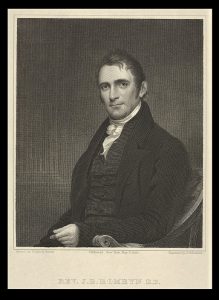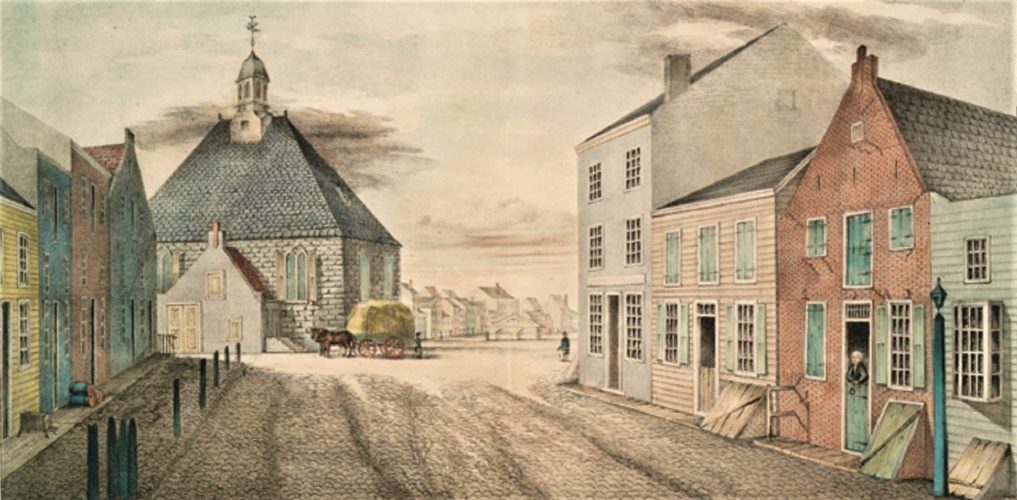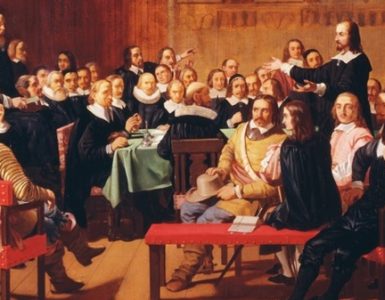 John Brodhead was born November 8, 1777 in Marbletown, New York, the only son of Dirick and Elizabeth (Brodhead) Romeyn. Dirick was pastor of the united Reformed Dutch congregations of Hackensack and Schraalenburgh in New Jersey. The family had moved from their home in Hackensack to Marbletown out of concern British troops might attack during the Revolution. In 1784, Pastor Romeyn moved the family to Schenectady so he could minister in the village Reformed Dutch Church. John began classical studies in an academy that his father helped establish and then joined the senior class of Columbia College in New York where he graduated with high honors in 1795. The following year he became a communicant member of his father’s church.
John Brodhead was born November 8, 1777 in Marbletown, New York, the only son of Dirick and Elizabeth (Brodhead) Romeyn. Dirick was pastor of the united Reformed Dutch congregations of Hackensack and Schraalenburgh in New Jersey. The family had moved from their home in Hackensack to Marbletown out of concern British troops might attack during the Revolution. In 1784, Pastor Romeyn moved the family to Schenectady so he could minister in the village Reformed Dutch Church. John began classical studies in an academy that his father helped establish and then joined the senior class of Columbia College in New York where he graduated with high honors in 1795. The following year he became a communicant member of his father’s church.
He began theological studies with John H. Livingston but returned to Schenectady to complete ministerial training with his father. He was licensed to preach by the Classis of Albany, June 20, 1798, and then May 17, 1799 he was examined for ordination by the Classis of Poughkeepsie and later that month was installed in the Reformed Dutch Church in Rhinebeck, New York. But his tenure was brief because he soon left the Reformed Dutch to go seventy miles up the Hudson River to pastor the First Presbyterian Church in Schenectady. The congregation had been divided regarding the most suitable of several candidates for its pulpit but came together to call Romeyn. Romeyn was able to settle the congregation and achieve harmony during the year he was its minister.
In November, 1804, he received a call from the First Presbyterian Church in Albany. He struggled with whether or not he should make the change but advice from friends and respected acquaintances influenced him to accept the call. His farewell sermon was delivered in Schenectady, December 2, 1804, and he was installed in Albany just a few days later. The congregation was the only Presbyterian one in the city. Since Albany was the capital many church members and regular attendees were legislators, clerks, and administrators for the state of New York. During legislative sessions the pews were filled with visitors from all over the country. It may have been an intimidating situation for a pulpit minister because he faced politicians in the pews who were gifted rhetoricians, but by all accounts Pastor Romeyn was a fine preacher who continued in the capable vein of the two previous ministers, John McDonald and Eliphalet Nott. He was able to adapt to the situation without remembrance of his predecessors overshadowing his ministry. He continued in Albany for four years.
When the church on Cedar Street in New York was established in 1808, Romeyn was sought for its first minister. He was issued a call in May and notes containing his thoughts about the opportunity were located among his papers when his estate was processed.
I discouraged the idea; but they made out the call, and prosecuted it, notwithstanding that discouragement. It was offered to me, because they knew I was not in good health, and a change might be of service. The Cedar Street Church bids fair to be large and respectable; and, from the character of the subscribers, a Gospel ministry, if successful among them, will have the most salutary effects upon a large portion of the inhabitants of the city. The members are unanimous in the call made on me. My wife’s health will, I believe, be benefitted by sea air. My mother and sister approve of a removal. These considerations, added to my health, seem to make it my duty to remove.
Romeyn relocated to New York and in November 1808 was installed the minister of Cedar Street Church. As Cedar Street grew so did Romeyn’s ministry not only to the congregation but also in the extended Presbyterian Church.
The General Assembly of the Presbyterian Church in the United States of America convened in First Church, Philadelphia, the morning of May 17, 1810. After a sermon from the text, “For unto whomsoever much is given, of him shall be much required” (Luke 12:48), by retiring Moderator John H. Rice and the enrollment of commissioners, John B. Romeyn was elected moderator. Issues addressed included the establishment of a theological school which would come to fruition in Princeton, 1812. A key issue of debate was the previous Assembly’s resolution to require presbyteries to examine sessional records annually. This seems an unusual topic to have caused considerable debate, but sometimes there is more to the issue of discussion than the issue itself. The Presbytery of Philadelphia had sent a “remonstrance” to repeal the action because of doubts of its constitutionality and presbyteries already had ingrained practices as to how to review the records. The subject was debated for quite some time, hours, maybe even a day or more. In the end, it was decided not to repeal the decision of the previous Assembly but instead it was effectively negated by the words of the resolution adopted, “the Assembly are by no means disposed to urge any Presbytery to proceed under this order, beyond what they may consider prudent and useful.” Thus, it is a decision of the Assembly originally intended as instruction for all presbyteries to follow, but it is acceptable for a presbytery to choose not to follow it.
An item of doctrinal interest was the appeal by William C. Davis of the decision of the Synod of the Carolinas regarding his theological views expressed in his 628 page book, The Gospel Plan, 1809. The Assembly decided in favor of Davis not because it approved of his views but because the Synod of the Carolinas had tried him without a reference or appeal before it to prosecute. Davis was vindicated regarding procedure, but he would not be for his views. Later in the Assembly his book was examined by a committee with several recommendations concerning the views expressed. However, it was tabled after extended discussion. The report was finally adopted with one comment in the resolution summarizing his views as calculated “to produce useless or mischievous speculations.” Davis would go on to leave the denomination and along with several other churches supporting his views found the Independent Presbyterian Church in the Carolinas in and around York County.
The assembly adjourned at six the evening of May 31 after two weeks minus Sabbaths leaving twelve days for deliberations.
Romeyn struggled with his health throughout his ministry. In 1813 he was suffering so much that he felt a break was needed. In November, he, his wife, and nephew set sail for Portugal. After touring the Continent and England with a particularly enjoyable visit to the homeland of his ancestors in Holland, he returned to New York the following fall. The tour had provided connection with many people of interest in Europe and his visits to numerous book vendors aroused his bibliomania to purchase a considerable cache of books. His first sermon as rested and invigorated pastor back in New York was preached December 9, 1814 from Lamentations 3:21-23.
This I recall to my mind, therefore have I hope. It is of the Lord’s mercies that we are not consumed, because his compassions fail not. They are new every morning: great is thy faithfulness.
Dr. Romeyn continued ministerial duties until November 1824 when health issues limited his ability to serve. As the year turned, he resigned from the board of trustees of the College of New Jersey after sixteen years of service; he ended his work with Princeton Seminary’s Board of Trustees after thirteen years; and after fourteen years he resigned from Columbia University’s board of trustees. Less than two weeks before his death, he preached the text, “It is finished” (John 19:30), and then administered the Lord’s Supper. He commented that he believed it was the last distribution of the elements he would administer, and he was correct in his assessment. John B. Romeyn, D.D., died February 22, 1825, at the age of forty-seven during his twenty-sixth year of ministry. He had married April 22, 1799, Harriet Bleeker, the daughter of John N. Bleecker of Albany. They had but one child that died in infancy. Harriet survived her husband only a few months passing away October 23, 1825.
Dr. Romeyn was considered for a number of calls in both churches and education. He was offered a call to the Reformed Dutch Collegiate Churches in New York which he did not accept because at the same time he was deliberating the call he eventually accepted to Cedar Street. Both the presidencies of Transylvania University in Kentucky and Dickinson College in Pennsylvania were offered to him, but these he declined to continue pastoral work. In 1809, he was honored with the Doctor of Divinity by the College of New Jersey, and Union College had given him an honorary A. M. in 1797.
William B. Sprague provided a personal perspective on his preaching ability in Annals of the American Pulpit, vol. 4. He said that Romeyn’s published sermons
though highly respectable, will scarcely sustain the reputation that he enjoyed as a preacher. Some of his most wonderful sermons, when published, did not carry the same force as when they were delivered. His manner was so uncommonly impressive as necessarily to render them quite a different thing to the reader from what they were to the hearer.
Sprague’s comment about Romeyn is true of any sermon. There is always something missing when one reads just the text, but in the era, if sermons were to be provided for succeeding generations, the printed form was the only method. Today, the delivery of a sermon can be seen and heard through recording technology, viewed, and then the text read for further study, but the best approach is sitting in a congregation to hear a faithful exposition of the Bible during a service extending from the call to worship to the benediction.
Sprague is known today primarily for his massive collection of ministers’ biographies, Annals of the American Pulpit, but it is probably not known that he was a hoarder of pamphlets which in many cases are published sermons. I think nearly every minister must have delivered a sermon when General Washington died.
An Oration on the Death of Washington, 1800.
A Sermon on Resigning his Pastoral Charge at Rhinebeck, 1803.
A Sermon Delivered by Appointment of the Committee of Missions of the General Assembly of the Presbyterian Church in the United States, in the First Presbyterian Church in Philadelphia, 1808.
Two Sermons Delivered in the Presbyterian Church in Albany on the day recommended by the General Assembly of the Presbyterian Church for Fasting, Humiliation and Prayer, 1808.
An Introductory Sermon Delivered in the New Presbyterian Church in Cedar Street, New York, the first Sabbath after being installed Pastor of said Church, 1808.
The good Samaritan: A Sermon delivered in the Presbyterian Church in Cedar Street, New York, for the benefit of the New York Dispensary, 1810.
The Danger and Duty of Young People: A Sermon delivered in the Presbyterian Church in Cedar Street, New York, 1810.
An Exhortation to the People at the Ordination of the Rev. Gardiner Spring, 1810.
A Sermon Delivered at the Opening of the General Assembly of the Presbyterian Church, 1811. Report of a Committee of the General Assembly Appointed to Draft a Plan for Disciplining Baptized Children, 1812.
A Sermon Delivered in the Middle Dutch Church, New York, for the Benefit of the New York Marine Missionary Society, 1819.
The Duty and Reward of Honoring God: A Sermon Delivered in the Presbyterian Church in Cedar Street, New York, on the Anniversary of the Landing of the Pilgrims of New England, 1821.
Sprague relates the influences from Romeyn upon his own life.
I became acquainted with Dr. Romeyn first in June 1816, and knew him quite well till the close of his life. On my introduction to him, I was struck with his friendly and earnest manner, and it was at his suggestion and through his influence that I became a member of the Princeton Theological Seminary. I had heard him preach in his own church, in the preceding autumn, a very impressive discourse on that beautiful passage in Job, “Canst thou bind the sweet influences of Pleiades, or loose the bands of Orion?” on the Sabbath immediately succeeding a terrific and desolating gale, still remembered as the “September gale,” and the deep interest with which I had listened to that discourse made me the more desirous of obtaining an introduction to him. Before my course in the Seminary was closed, I spent a Sabbath with him at Elizabethtown, on a communion occasion in Dr. [John] McDowell’s church, when nearly one hundred new members were admitted; and I was exceedingly struck on that occasion with the appropriateness as well as the impressiveness of his public exercises. The last public occasion on which I saw him was the ordination of the Rev. A. Phoenix at Springfield, Chicopee Parish, Massachusetts a few months before his death. Mr. Phoenix and himself had been classmates in Columbia College and close friends in later life. At the time, Dr. Romeyn’s health was poor, but he still could not resist the desire to assist in putting his old friend into the ministry. The sermon he preached on the occasion evinced the great interest he had in the subject, while it was altogether a manly and vigorous effort. The most remarkable thing, however, in connection with the occasion was his asking a blessing at the table where the council dined after the ordination. Within the compass of a minute or two, he seemed to bring all the peculiar circumstances of the people and the pastor, and the newly formed relation between them, combining them in the most impressive and beautiful manner. The next afternoon, I heard him preach a communion lecture for Dr. Osgood at Springfield, after which he crossed the river, and preached for me in the evening at West Springfield, one of his most eloquent discourses. Though I saw evidence that his health was upon the wane, the freedom and vigor of his manner, and his power to impress an audience, seemed to me to have suffered no abatement. I parted with him the next morning, and never met him afterwards.
Barry Waugh
Notes—The portrait is from the frontispiece of his sermons titled, Sermons by John B. Romeyn, D.D., Pastor of the Presbyterian Church in Cedar Street, New York, 2 vols., New York, 1816. The header is from the NYPL Digital Collection and is titled “Church and Market Sts., Albany, 1805.” The Presbyterian Church in Cedar Street was incorporated in 1808; the name was changed in 1835 to The Presbyterian Church in Duane Street after Romeyn’s death; it was changed then to Fifth Avenue Church, corner of Nineteenth Street, 1852; and at the time of the centennial it had been named The Fifth Avenue Presbyterian Church since 1875. Its succession of pastors after Romeyn included Cyrus Mason, George Potts, D.D., James W. Alexander, D.D., Nathan L. Rice, D.D., John Hall, D.D., LL. D., George T. Purves, D.D., LL. D., and J. Ross Stevenson, D.D. The edition of the minutes used is the collection found in Minutes of the General Assembly, 1789-1820. Important sources include in addition to Sprague, the History of the First Presbyterian Church of Albany, N.Y., Lists of its Officers, and a Complete Catalogue of its Members from its Organization, Albany: Jenkins & Johnston, 1877; History of the Fifth Avenue Presbyterian Church of New York City, New York from 1808 to 1908 together with an Account of its Centennial Anniversary Celebration December 18-23, 1908, by Henry W. Jessup, published by the Centennial Committee, 1909. The Presbyterian Historical Society in Philadelphia has a one cubic foot collection titled, “Guide to the John Brodhead Romeyn Papers.”





